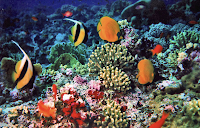 Karimunjawa National Park, also Karimun-Jawa National Park, is a national park designated in the Karimunjawa archipelago, Jepara regency, Central Java, Indonesia, at least 80 km north-west of Jepara, Central Java in the Java Sea. The national park was formally declared as Marine Protection Area in 2001. Based on popular local myth, this archipelago was discovered by Sunan Nyamplungan, the nephew of Sunan Kudus who is one of the Wali Sanga.
Karimunjawa National Park, also Karimun-Jawa National Park, is a national park designated in the Karimunjawa archipelago, Jepara regency, Central Java, Indonesia, at least 80 km north-west of Jepara, Central Java in the Java Sea. The national park was formally declared as Marine Protection Area in 2001. Based on popular local myth, this archipelago was discovered by Sunan Nyamplungan, the nephew of Sunan Kudus who is one of the Wali Sanga.  Karimunjawa is also a tourist attraction popular for its white sandy beach, pristine coral reefs, challenging treks through the hills, the pilgrimage to Sunan Nyamplungan Cemetery, and the customs and traditions of the Karimunjawa Community.
Karimunjawa is also a tourist attraction popular for its white sandy beach, pristine coral reefs, challenging treks through the hills, the pilgrimage to Sunan Nyamplungan Cemetery, and the customs and traditions of the Karimunjawa Community.
The Karimunjawa archipelago lies from 5o49' - 5o57' South latitude and 110o04' - 110o40' East Longitude in the Java Sea, north of Java. It is about 120 km from Semarang, the capital of Central Java Province. Comprising 27 islands, the Karimunjawa subdistrict is divided into three villages, namely Karimunjawa, Kamujan and Parang. The archipelago is under the administration of Jepara Regency, Central Java Province. Karimunjawa archipelago covering 111.625 ha in 2001, and area of 110.117,30 ha was declared as Marine Protection Area (MPA).
The geological formation in the archipelago is mostly dominated by quartz sand stone, gravel, mud, and clay. The topography of Karimunjawa Marine National Park is a wave of low land, with elevation ranging from 0 - 506 above sea level. Gajah hill is the park's highest point. Temperature range from 30 - 31oC.
 The biggest island in the archipelago is Karimunjawa island, town or villages are located in Karimunjawa. Kemujan, Nyamuk, Parang and Genting island, the other island are uninhabited.
The biggest island in the archipelago is Karimunjawa island, town or villages are located in Karimunjawa. Kemujan, Nyamuk, Parang and Genting island, the other island are uninhabited.Karimunjawa's coral reefs are made up of fringing reefs, barrier reefs and several patch reefs. They have an extraordinary wealth of species 51 genera with more than 90 species of coral biota and 242 species of ornamental fish. Two protected biota species, black coral (Antiphates sp.) and Organ pipe coral (Tubipora musica), can be found here. Other protected sea biota include the hornet helmet (Cassis comute), Triton trumpet (Charonia tritonis), Chambered nautilus, Green shell (Turbo marmoratus), and six species of clam. Around Kemujan island, the wreck of the Panamanian ship Indono, which sank to the sea bed in 1955, is now a habitat of coral fish and is a polular site for wreck diving.
The lowland tropical forest covers an area of 1.285,50 ha. It provides habitat to a number of endemic species including the Mythical Dewadaru tree (Fagraea elliptica), Setigi (Pemphis acidula) and Kalimasada (Cordia subcordata). The local people use these trees as raw material for souvenir handicraft such as for tasbih, kris or staffs. It is generally believed that the wood of the endemic Dewadaru trees has a legendary power or curing diseases or snake bite wounds, protecting house from thieves, or prolonging life. Recently, the population of these three tree species has deteriorated because of the increased extraction.
There are about forty different bird species in the island, including the Green imperial-pigeon (Ducula aenea), Yellow-vented bulbul (Pycnonotus goiavier) and Red breasted parakeet (Psittacula alexandry). Some migratory birds are also found in this area, such as the Common sandpiper and Whimbrel. The lowland tropical rain forest is the natural habitat of the rare White-hellied sea eagle. The latest expedition report of the Indonesian Science Institute reveals that there are two endemic butterfly species, and these are the Euploea crameri karimodjawaensis and the Idea leuconoe karimodjawaensis.
 Based on the functions, Karimunjawa National Parks was divided into four zones :
Based on the functions, Karimunjawa National Parks was divided into four zones :- Sanctuary Zone (1.299 ha), a no take zone consisting of Burung and Geleang island. Research and education is permitted.
- Wilderness Zone (7.801 ha), research is permitted and tourist activity is limited, it consist of Krakal Besar, Krakal Kecil, Menyawakan, Cemara Besar, Cemara Kecil, Bengkoang and part of Karimunjawa and Kemujan island.
- Utilization Zone (4.431 ha), consist Menjangan Besar, Menjangan Kecil, Kembang, Kembar, Karang Katang, Karang Kapal, Parang, Karimunjawa and Kemujan.
- Buffer Zone (98.093,5 ha), comprises Karimunjawa, Kemujan, Parang and Nyamuk. These islands are inhabited.
The population of Karimunjawa District is 8.842, most of whom are fishermen. Karimunjawa community consist of many ethnic groups such as Javanese, Madurese, Bugis, Mandar and Luwu. The Javanese people are popularly known for their agricultural activity and their production of household utensils. The Bugis are known for their seafaring activity, and naturally they are associated with fishermen. The Madurese are known their salted fish production. They live in harmony and have created a new behaviour and tradition.
Declared by Minister of Forestry No. 78/Kpts-II/1999, February 22, 1999.




